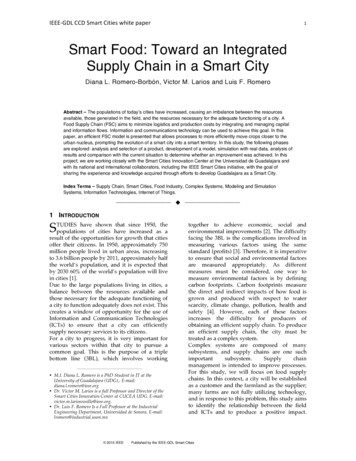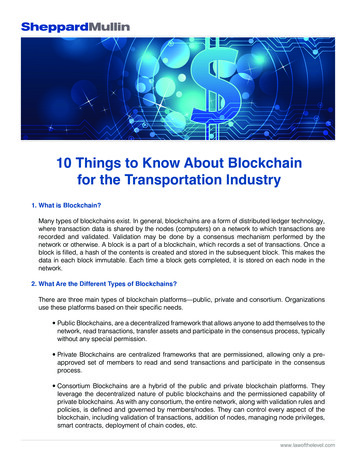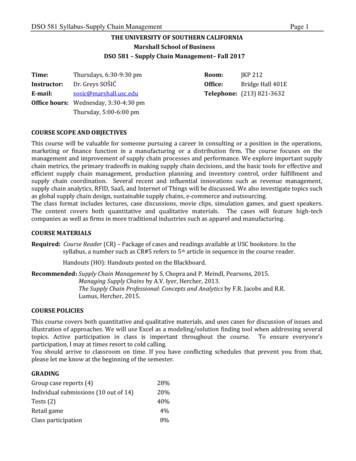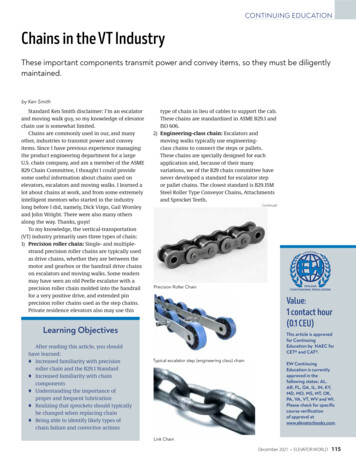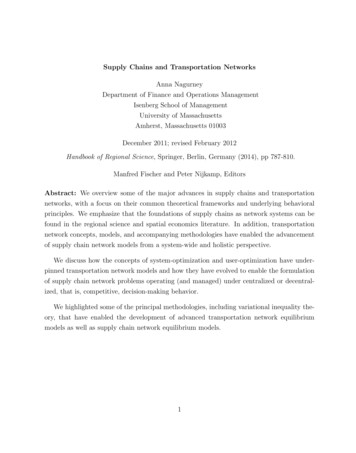
Transcription
Supply Chains and Transportation NetworksAnna NagurneyDepartment of Finance and Operations ManagementIsenberg School of ManagementUniversity of MassachusettsAmherst, Massachusetts 01003December 2011; revised February 2012Handbook of Regional Science, Springer, Berlin, Germany (2014), pp 787-810.Manfred Fischer and Peter Nijkamp, EditorsAbstract: We overview some of the major advances in supply chains and transportationnetworks, with a focus on their common theoretical frameworks and underlying behavioralprinciples. We emphasize that the foundations of supply chains as network systems can befound in the regional science and spatial economics literature. In addition, transportationnetwork concepts, models, and accompanying methodologies have enabled the advancementof supply chain network models from a system-wide and holistic perspective.We discuss how the concepts of system-optimization and user-optimization have underpinned transportation network models and how they have evolved to enable the formulationof supply chain network problems operating (and managed) under centralized or decentralized, that is, competitive, decision-making behavior.We highlighted some of the principal methodologies, including variational inequality theory, that have enabled the development of advanced transportation network equilibriummodels as well as supply chain network equilibrium models.1
1. IntroductionSupply chains are networks of suppliers, manufacturers, transportation service providers,storage facility managers, retailers, and consumers at the demand markets. Supply chainsare the backbones of our globalized Network Economy and provide the infrastructure forthe production, storage, and distribution of goods and associated services as varied as foodproducts, pharmaceuticals, vehicles, computers and other high tech equipment, buildingmaterials, furniture, clothing, toys, and even electricity.Supply chains may operate (and be managed) in a centralized or decentralized manner and be underpinned not only by multimodal transportation and logistical networks butalso by telecommunication as well as financial networks. In a centralized supply chain,there is a central entity or decision-maker, such as a firm, that controls the various supplychain network activities whereas in a decentralized supply chain, there are multiple economic decision-makers and the governing paradigm is that of competitive behavior amongthe relevant stakeholders, with different degrees of cooperation. For example, in a verticallyintegrated supply chain the same firm may be responsible for production, storage, and distribution of its products. On the other hand, certain industry supply chain network structuresmay consist of competitive manufacturers, competitive distributors, as well as competingretailers. Nevertheless, the stakeholders involved in supply chains must cooperate to theextent that the products be received and processed as they move downstream in the supplychain (Nagurney (2006)).The complexity and interconnectivity of some of today’s product supply chains have beenvividly illustrated through the effects of recent natural disasters, including earthquakes,tsunamis, and even hurricanes, which have severed critical nodes and/or links and havedisrupted the production and transportation of products, with major economic implications.Indeed, when supply chain disruptions occur, whether due to natural disasters, human error,attacks, or even market failure, the ramifications can propagate and impact the health andwell-being of the citizenry thousands of miles away from the initially affected location (cf.Nagurney and Qiang (2009)).Since supply chains are network systems, any formalism that seeks to model supply chainsand to provide quantifiable insights and measures must be a system-wide one and network2
based. Such crucial issues as the stability and resiliency of supply chains, as well as theiradaptability and responsiveness to events in a global environment of increasing risk anduncertainty, can only be rigorously examined from the view of supply chains as networksystems (Nagurney (2006)).Supply chains share many of the same characteristics as other network systems; including a large-scale nature and complexity of network topology; congestion, which leads tononlinearities; alternative behavior of users of the networks, which may lead to paradoxicalphenomena (recall the well-known Braess paradox in which the addition of a new road mayincrease the travel time for all); possibly conflicting criteria associated with optimization(the minimization of time for delivery, for example, may result in higher emissions); interactions among the underlying networks themselves, such as the Internet with electric powernetworks, financial networks, and transportation and logistical networks, and the growingrecognition of their fragility and vulnerability. Moreover, policies surrounding supply chainnetworks today may have major implications not only economically, but also socially, politically, and security-wise.Although, historically, supply chain activities of manufacturing, transportation / distribution, as well as inventorying / storage have each, independently, received a lot of attentionfrom both researchers and practitioners, the framework of supply chains views the variousactivities of production, transportation, and consumption in an integrated, holistic manner.Indeed, without the critical transportation links what is manufactured cannot be delivered topoints of demand. Moreover, needed inputs into the production processes / manufacturinglinks cannot be secured.While, beginning in the 1980s (cf. Handfield and Nichols, Jr. (1999)), supply chains havecaptured wide interest among practitioners as well as researchers, it may be argued that thefoundations of supply chain networks can be found in regional science and spatial economics,dating to the classical spatial price equilibrium models of Samuelson (1952) and Takayamaand Judge (1971) with additional insights as to production processes, transportation anddistribution provided by Beckmann, McGuire, and Winsten (1956). For example, in spatialprice equilibrium models not only is production of the commodity in question considered atmultiple locations or supply markets, with appropriate underlying functions, but also the3
consumption of the commodity at the demand markets, subject to appropriate functions(either demand or demand price) as well as the cost associated with transporting the commodity between pairs of the spatially separated supply and demand markets. Spatial priceequilibrium models have evolved to include multiple commodities, multiple modes of transportation, and may even include general underlying transportation networks. Moreover, withadvances in theoretical frameworks, including, for example, the theory of variational inequalities (Nagurney (1999)), one can now formulate and solve complex spatial price equilibriumproblems with asymmetric supply price, demand price, and unit transportation/transactioncost functions (for which an optimization reformulation of the governing spatial price equilibrium conditions does not hold).In addition, versions of spatial equilibrium models that capture oligopolistic behaviorunder imperfect, as opposed to perfect, competition serve as some of the basic supply chainnetwork models in which competition is included but, at the same time, the importantdemand/consumption side is also captured (see Nagurney (1999) and the references therein).Interestingly, spatial price equilibrium problems can be reformulated and solved as transportation network equilibrium problems with elastic demands over appropriately constructedabstract networks or supernetworks (see Nagurney and Dong (2002)). Hence, the plethora ofalgorithms that have been developed for transportation networks (cf. Sheffi (1985), Patriksson (1994), Nagurney (1999), and Ran and Boyce (1996)) can also be applied to computesolutions to spatial price equilibrium problems. It is worth noting that Beckmann, McGuire,and Winsten in their classical 1956 book, Studies in the Economics of Transportation, formulated transportation network equilibrium problems with elastic demands. They provedthat, under the assumed user link cost functional forms and the travel disutility functionalforms associated with the origin/destination pairs of nodes that the governing equilibriumconditions (now known as user-optimized conditions) in which no traveler has any incentiveto alter his route of travel, given that the behavior of others is fixed, could be reformulatedand solved as an associated optimization problem. In their book, they also hypothesized thatelectric power generation and distribution networks, or in today’s terminology, electric powersupply chains, could be transformed into transportation network equilibrium problems. Thishas now been established (cf. Nagurney (2006) and the references therein).4
Today, the behavior of travelers on transportation networks is assumed to follow one ofWardrop’s (1952) two principles of travel behavior, now renamed, according to Dafermos andSparrow (1969), as user-optimized (selfish or decentralized) or system-optimized (unselfishor centralized). The former concept captures individuals’ route-taking decision-making behavior, whereas the latter assumes a central controller that routes the flow on the networkso as to minimize the total cost.Moreover, a plethora of supply chain network equilibrium models, originated by Nagurney, Dong, and Zhang (2002), have been developed in order to address competition amongdecision-makers in a tier of a supply chain whether among the manufacturers, the distributors, the retailers, and/or even the consumers at the demand markets. Such models capturethe behavior of the individual economic decision-makers, as in the case, for example, ofprofit maximization and acknowledge that consumers also take transaction/transportationcosts into consideration in making their purchasing decisions. Prices for the product associated with each decision-maker at each tier are obtained once the entire supply chain networkequilibrium problem is solved, yielding also the equilibrium flows of the product on the linksof the supply chain network. Such supply chain network equilibrium models also possess (asspatial price equilibrium problems highlighted above) a transportation network equilibriumreformulation.Supply chain network models have been generalized to include electronic commerce options, multiple products, as well as risk and uncertainty, on the demand-side as well as onthe supply-side (cf. Nagurney (2006) and the referenced therein). In addition, and, this isproduct-specific, supply chain network models have also been constructed to handle timesensitive products (fast fashion, holiday-based, and even critical needs as in disasters) aswell as perishable products (such as food, cut flowers, certain vaccines and medicines, etc.)using multicriteria decision-making formalisms for the former and generalized networks forthe latter (see Masoumi, Yu, and Nagurney (2012)). Both static as well as dynamic supplychain network models, including multiperiod ones with inventorying have been formulated,solved, and applied.It is important to note that not all supply chains are commercial and, in fact, given thatthe number of disasters is growing, as is the number of people affected by them, humanitar-5
ian supply chains have emerged as essential elements in disaster recovery. Unlike commercialor corporate supply chains, humanitarian supply chains are not managed using profit maximization as a decision-making criterion (since donors, for example, would not approve) butrather cost minimization subject to demand satisfaction under uncertainty is relevant (seeNagurney and Qiang (2009)). In addition, such supply chains may need to be constructedquickly and with the cognizant decision-makers working under conditions of damaged, if notdestroyed, infrastructure, and limited information.Supply chain decision-making occurs at different levels – at the strategic, tactical, andoperational levels. Strategic decisions may involve where to locate manufacturing facilitiesand distribution centers, whereas tactical decisions may include with which suppliers topartner and which transportation service providers (carriers) to use. Decisions associatedwith operational supply chain decision-making would involve how much of the product toproduce at which manufacturing plants, which storage facilities to use and how much tostore where, as well as how much of the product should be supplied to the different retailersor points of demand. In addition, because of globalization, supply chain decision-makingmay now involve outsourcing decisions as well as the accompanying risk management.Today, it has been argued that, increasingly, in the Network Economy it is not onlycompetition within a product supply chain that is taking place but, rather, supply chainversus supply chain competition. Zhang, Dong, and Nagurney (2003) generalized Wardrop’sfirst principle of travel behavior to formulate competition among supply chains.Location-based decisions are fundamental to supply chain decision-making, design, andmanagement. Furthermore, such decisions affect spatial competition as well as trade, withOhlin (1933) and Isard (1954) noting the need to integrate industrial location and international trade in a common framework.Nagurney (2010) constructed a system-optimization model that can be applied to thedesign or redesign of a supply chain network and has as endogenous variables both thecapacities associated with the links (corresponding to manufacturing, transportation, andstorage), as well as the operational flows of the product in order to meet the demands. Themodel has been extended in various directions to handle oligopolistic competition as well asproduct perishability in specific applications (cf. Masoumi, Yu, and Nagurney (2012) and6
the references therein).At the same time that supply chains have become increasingly globalized, environmentalconcerns due to global warming and associated risks have drawn the attention of numerous constituencies. Firms are increasingly being held accountable not only for their ownperformance in terms of their environmental performance, but also for that of their suppliers, subcontractors, joint venture partners, distribution outlets and, ultimately, even for thedisposal of their products. Consequently, poor environmental performance at any stage ofthe supply chain may damage the most important asset that a company has, which is itsreputation. Hence, the topic of sustainable supply chain network modeling and analysis hasemerged as an essential area for research, practice, as well as for policy analysis (see Boone,Jayaraman, and Ganeshan (2012)).7
2. Fundamental Decision-Making Concepts and ModelsIn this section of this essay, we interweave fundamental concepts in transportation thathave been used successfully and with wide application in supply chain network modeling,analysis, operations management, and design. Our goal is to provide the necessary background from which additional explorations and advances can be made using a readable andaccessible format.As noted in the Introduction, over half a century ago, Wardrop (1952) considered alternative possible behaviors of users of transportation networks, notably, urban transportationnetworks, and stated two principles, which are named after him:First Principle: The journey times of all routes actually used are equal, and less thanthose which would be experienced by a single vehicle on any unused route.Second Principle: The average journey time is minimal.The first principle corresponds to the behavioral principle in which travelers seek to(unilaterally) determine their minimal costs of travel; the second principle corresponds tothe behavioral principle in which the total cost in the network is minimal.Beckmann, McGuire, and Winsten (1956) were the first to rigorously formulate theseconditions mathematically and proved the equivalence between the transportation networkequilibrium conditions, which state that all used paths connecting an origin/destination(O/D) pair will have equal and minimal travel times (or costs) (corresponding to Wardrop’sfirst principle), and the Kuhn-Tucker conditions of an appropriately constructed optimization problem, under a symmetry assumption on the underlying functions. Hence, in thiscase, the equilibrium link and path flows could be obtained as the solution of a mathematical programming problem. Their fundamental result made the formulation, analysis, andsubsequent computation of solutions to transportation network problems based on actualtransportation networks realizable.Dafermos and Sparrow (1969) coined the terms user-optimized (U-O) and system-optimized(S-O) transportation networks to distinguish between two distinct situations in which, respectively, travelers act unilaterally, in their own self-interest, in selecting their routes, and8
Table 1: Distinct Behavior on Transportation NetworksUser-Optimization User Equilibrium Principle:User travel costs on used paths foreach O/D pair are equalized andminimal.System-Optimization System Optimality Principle:Marginals of the total travel cost onused paths for each O/D pair areequalized and minimal.in which travelers choose routes/paths according to what is optimal from a societal pointof view, in that the total cost in the network system is minimized. In the latter problem,marginal total costs rather than average costs are equilibrated. As noted in the Introduction,the former problem coincides with Wardrop’s first principle, and the latter with Wardrop’ssecond principle. Table 1 highlights the two distinct behavioral principles underlying transportation networks.The concept of “system-optimization” is also relevant to other types of “routing models” in transportation, including those concerned with the routing of freight. Dafermos andSparrow (1969) also provided explicit computational procedures, that is, algorithms, to compute the solutions to such network problems in the case where the user travel cost on a linkwas an increasing (in order to handle congestion) function of the flow on the particularlink, and linear. Today, the concepts of user-optimization versus system-optimization alsocapture, respectively, decentralized versus centralized decision-making on supply chain networks after the proper identifications are made (Boyce, Mahmassani, and Nagurney (2005)and Nagurney (2006)).2.1 User-Optimization versus System-OptimizationIn this section, the basic transportation network models are first recalled, under distinctassumptions as to their operation and the underlying behavior of the users of the network.The models are classical and are due to Beckmann, McGuire, and Winsten (1956) andDafermos and Sparrow (1969). In subsequent sections, we present more general modelsin which the user link cost functions are no longer separable but, rather, are asymmetric.9
For such models we also provide the variational inequality formulations of the governingequilibrium conditions, since, in such cases, the governing equilibrium conditions can nolonger be reformulated as the Kuhn-Tucker conditions of a convex optimization problem.The presentation follows that in Nagurney (2007) with addition of material on supply chainswith synthesis.For easy accessibility, we recall the classical user-optimized network model in Section2.1.1 and then the classical system-optimized network model in Section 2.1.2. The Braess(1968) paradox is, subsequently, highlighted in Section 2.1.3.2.1.1 The User-Optimized ProblemThe user-optimized network problem is also commonly referred to in the transportationliterature as the traffic assignment problem or the traffic network equilibrium problem.Consider a general network G [N , L], where N denotes the set of nodes, and L the setof directed links. Links connect pairs of nodes in the network and are denoted by a, b, etc.Let p denote a path consisting of a sequence of links connecting an origin/destination (O/D)pair of nodes. Paths are assumed to be acyclic and are denoted by p, q, etc. In transportationnetworks, nodes correspond to origins and destinations, as well as to intersections. Links,on the other hand, correspond to roads/streets in the case of urban transportation networksand to railroad segments in the case of train networks. A path in its most basic setting,thus, is a sequence of “roads” which comprise a route from an origin to a destination. In thesupply chain network context, links correspond to supply chain activities (with appropriateassociated cost functions) and represent manufacturing, transportation/shipment, storage,etc. In addition, links can correspond to outsourcing links (see Nagurney (2006)).Here we consider paths, rather than routes, since the former subsumes the latter. Thenetwork concepts presented here are sufficiently general to abstract not only transportationdecision-making but also combined/integrated location-transportation decision-making aswell as a spectrum of supply chain decisions. In addition, in the setting of supernetworks,that is, abstract networks, in which nodes need to correspond to locations in space (seeNagurney and Dong (2002)), a path is viewed more broadly and need not be limited toa route-type decision but may, in fact, correspond to not only transportation but also to10
manufacturing and inventorying/storage decision-making.Let Pω denote the set of paths connecting the origin/destination (O/D) pair of nodesω. Let P denote the set of all paths in the network and assume that there are J origin/destination pairs of nodes in the set Ω. Let xp represent the nonnegative flow on pathp and let fa denote the flow on link a. All vectors here are assume to be column vectors.nPThe path flows on the network are grouped into the vector x R , where nP denotesthe number of paths in the network. The link flows, in turn, are grouped into the vectornLf R , where nL denotes the number of links in the network.Assume, as given, the demand associated with each O/D pair ω, which is denoted by dω ,for ω Ω. In the network, the following conservation of flow equations must hold:dω Xxp , ω Ω,(1)p Pωwhere xp 0, p P ; that is, the sum of all the path flows between an origin/destinationpair ω must be equal to the given demand dω .In addition, the following conservation of flow equations must also hold:fa Xxp δap , a L,(2)p Pwhere δap 1, if link a is contained in path p, and 0, otherwise. Expression (2) states thatthe flow on a link a is equal to the sum of all the path flows on paths p that contain (traverse)link a.Equations (1) and (2) guarantee that the flows in the network (be they travelers, products,etc.) are conserved, that is, do not disappear (or are lost) in the network and arrive at thedesignated destinations from the origins.Let ca denote the user link cost associated with traversing link a, and let Cp denote theuser cost associated with traversing the path p. Assume that the user link cost function isgiven by the separable function in which the cost on a link depends only on the flow on thelink, that is,ca ca (fa ), a L,(3)11
where ca is assumed to be continuous and an increasing function of the link flow fa in orderto model the effect of the link flow on the cost and, in particular, congestion.The cost on a path is equal to the sum of the costs on the links that make up that path,that is,Cp Xca (fa )δap , p P.(4)a LTransportation Network Equilibrium ConditionsIn the case of the user-optimization (U-O) problem one seeks to determine the path flowpattern x (and the corresponding link flow pattern f ) which satisfies the conservationof flow equations (1) and (2), and the nonnegativity assumption on the path flows, andwhich also satisfies the transportation network equilibrium conditions given by the followingstatement. For each O/D pair ω Ω and each path p Pω :(Cp λω , if x p 0 λω , if x p 0.(5)In the user-optimization problem there is no explicit optimization criterion, since usersof the transportation network system act independently, in a non-cooperative manner, untilthey cannot improve on their situations unilaterally and, thus, an equilibrium is achieved,governed by the above equilibrium conditions. Conditions (5) are simply a restatement ofWardrop’s (1952) first principle mathematically and mean that only those paths connectingan O/D pair will be used which have equal and minimal user costs. In (5) the minimal costfor O/D pair ω is denoted by λω and its value is obtained once the equilibrium flow pattern isdetermined. Otherwise, a user of the network could improve upon his situation by switchingto a path with lower cost.Beckmann, McGuire, and Winsten (1956) established that the solution to the networkequilibrium problem, in the case of user link cost functions of the form (3), in which thecost on a link only depends on the flow on that link and is assumed to be continuous andan increasing function of the flow, could be obtained by solving the following optimization12
problem:X Z faMinimizea L 0ca (y)dy(6)subject to:Xxp dω , ω Ω,(7) a L,(8)p Pωfa Xxp δap ,p Pxp 0, p P.(9)The objective function given by (6) is simply a device constructed to obtain a solutionusing general purpose convex programming algorithms. It does not possess the economicmeaning of the objective function encountered in the system-optimization problem which willbe recalled below. Note that in the case of separable, as well as nonseparable, but symmetric(which we come back to later), user link cost functions, the λω term in (5) corresponds tothe Lagrange multiplier associated with the constraint (7) for that O/D pair ω. However, inthe case of nonseparable and asymmetric functions there is no optimization reformulation ofthe transportation network equilibrium conditions (5) and the λω term simply reflects theminimum user cost associated with the O/D pair ω at the equilibrium. As noted as earlyas Dafermos and Sparrow (1969), the above network equilibrium conditions also correspondto a Nash equilibrium (see Nash (1951)). The equilibrium link flow pattern is unique forproblem (6), subject to (7) – (9), if the objective function (6) is strictly convex (for additionalbackground on optimization theory.It has also been established (cf. Nagurney (2006) and the references therein) that multitiered supply chain network problems in which decision-makers (manufacturers, retailers,and even consumers) compete across a tier of the supply chain network but cooperate between tiers, as depicted in Figure 1, could be transformed into a transportation networkequilibrium problem using a supernetwork transformation, as in Figure 2. In Figure 2, theactivities of manufacturing and retailer handling/storage are associated with the top-mostand the third sets of links, respectively. The second and fourth sets of links from the topin Figure 2 are the transportation links (as is the case with the links in Figure 1). Thisconnection provides us with a path flow efficiency interpretation of supply chain networkequilibria. She utilized variational inequality theory (see below) to establish the equivalence.13
Manufacturers 1···i···m1···j···n1···k··· PP H H @ PP H P @PP H H P@ H P P PH PP H @ HP @ HPR j?HqP) ? Retailers PP H @ PPH H P@PP H H P P@ HHP P HHPP @ PP @ HR j?H) qP? o Demand MarketsFigure 1: The Multitiered Network Structure of the Supply Chain0nHH HH HH ai HH j ?nxnxnxm······1i X H HX X HHXX H XXX H HH Xa H X ijX H XHXH HHXHXH j jz?X9 ? nnyy1yn······jnajj 00y1nU?···0yjn?···0ynn?X HXXX H HH X ajH 0k X H X H X H XX H XXH H XH XH H XH j H j9 z?X? ?nnz1zkzn······oFigure 2: The Supernetwork Representation of Supply Chain Network Equilibrium14
2.1.2 The System-Optimized ProblemWe now recall the system-optimized problem. As in the user-optimized problem of Section2.1.1, the network G [N , L], the demands associated with the origin/destination pairs, andthe user link cost functions are assumed as given. In the system-optimized problem, there isa central controller who routes the flows in an optimal manner so as to minimize the totalcost in the network. This problem has direct relevance to the management of operations ofa supply chain.The total cost on link a, denoted by ĉa (fa ), is given by:ĉa (fa ) ca (fa ) fa , a L,(10)that is, the total cost on a link is equal to the user link cost on the link times the flow on thelink. As noted earlier, in the system-optimized problem, there exists a central controller whoseeks to minimize the total cost in the network system, which can correspond to a supplychain, where the total cost is expressed asXĉa (fa ),(11)a Land the total cost on a link is given by expression (10).The system-optimization (S-O) problem is, thus, given by:XMinimizeĉa (fa )(12)a Lsubject to the same conservation of flow equations as for the user-optimized problem, as wellas the nonnegativity assumption of the path flows; that is, constraints (7), (8), and (9) mustalso be satisfied for the system-optimized problem.The total cost on a path, denoted by Ĉp , is the user cost on a path times the flow on apath, that is,Ĉp Cp xp , p P,(13)where the user cost on a path, Cp , is given by the sum of the user costs on the links thatcomprise the path (as in (4)), that is,Cp Xca (fa )δap ,a L15 a L.(14)
In view of (2), (3), and (4), one may express the cost on a path p as a function of the pathflow variables and, hence, an alternative version of the above system-optimization problemwith objective function (12) can be stated in path flow variables only, where one has nowthe problem:MinimizeXCp (x)xp(15)p Psubject to constraints (7) and (9).System-Optimality ConditionsUnder the ass
competition within a product supply chain that is taking place but, rather, supply chain versus supply chain competition. Zhang, Dong, and Nagurney (2003) generalized Wardrop's first principle of travel behavior to formulate competition among supply chains. Location-based decisions are fundamental to supply chain decision-making, design, and




